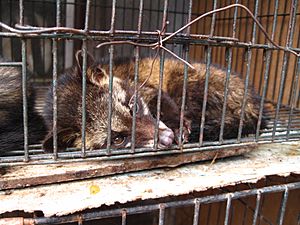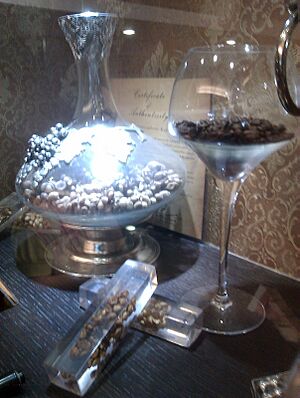Kopi luwak facts for kids
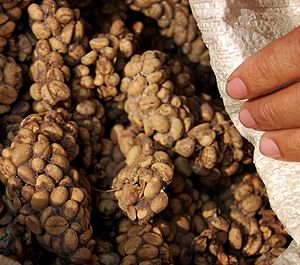 |
|
| Alternative names | Indonesian pronunciation: [ˈkopi ˈlu.aʔ] |
|---|---|
| Place of origin | Indonesia |
| Main ingredients | Coffea arabica |
Kopi luwak is a special type of coffee. It is made from coffee cherries that have been eaten and then passed through the body of an animal called the Asian palm civet. This animal is a small creature that looks a bit like a cat.
People also call it civet coffee. As the coffee cherries go through the civet's body, they get fermented. This means they change in a special way, similar to how some foods are made. After the civet passes them out, the coffee beans are collected. Sadly, more and more Asian palm civets are being caught from the wild for this purpose.
Kopi luwak is mostly made in Indonesia. You can find it on islands like Sumatra, Java, Bali, and Sulawesi. It's also made in East Timor and the Philippines. In the Philippines, it has different local names like kape motit or kapé alamíd. In Vietnam, it's sometimes called weasel coffee.
People who make this coffee believe the civets help in two ways. First, the civets choose only the best coffee cherries to eat. Second, the civet's body changes the coffee beans as they pass through, which they say makes the coffee taste better.
Originally, people found these coffee beans in the wild. But now, many civets are kept in cages on farms. They are often forced to eat the coffee cherries. This way of making coffee has caused worries about how the civets are treated. They might live in small cages, have a poor diet, and get sick easily.
Even though kopi luwak is just a way of processing coffee, it is known as one of the most expensive coffees in the world. Farmed beans can cost around $100 per kilogram. Beans collected from wild civets can be much more expensive, sometimes over $1300 per kilogram!
Contents
How Kopi Luwak Started
The story of kopi luwak is linked to how coffee first came to Indonesia. In the 1800s, Dutch rulers started coffee farms there. They brought coffee beans from Yemen. Farmers in Java noticed that civets ate the coffee cherries and then passed them out. These farmers started collecting these beans and brewing coffee from them. This was the beginning of kopi luwak.
Making Kopi Luwak Coffee
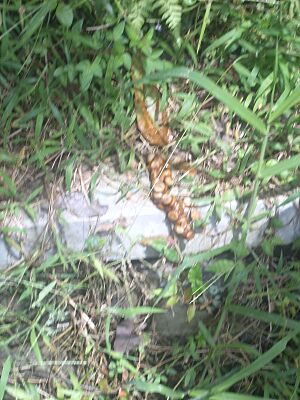
Kopi luwak is made from coffee beans that have traveled through the civet's digestive system. Inside the civet, the beans are changed by acids and special chemicals called enzymes. These changes break down some parts of the coffee beans. This can affect how the coffee smells when it's roasted.
People think that civets pick only the ripest and best coffee cherries. This choice, along with the digestion process, can change the coffee's flavor. The beans also start to sprout a little, which can make them less bitter. In nature, these steps are like how coffee farmers carefully pick ripe cherries and remove the outer layers.
In the past, people collected these special coffee beans from wild civets in forests and on farms. But as more people wanted kopi luwak, some producers started keeping civets in cages. This helps them make more coffee.
In 2014, it was thought that less than 127 kilograms of kopi luwak were made each year. It is produced in countries like Indonesia, East Timor, the Philippines, Thailand, Vietnam, and Ethiopia.
What Does Kopi Luwak Taste Like?
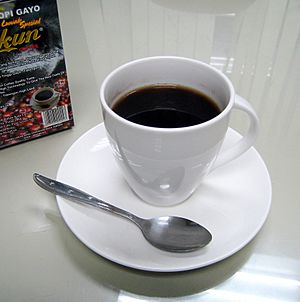
The taste of kopi luwak can be different depending on many things. These include the type of coffee bean, how it was processed, how it was roasted, and how it was brewed. Even the civet's health and stress levels might affect the taste.
Many coffee experts don't think kopi luwak tastes great. They often see it as a fun or unusual item, rather than a high-quality coffee. One expert compared kopi luwak to other coffees. He found that kopi luwak scored lower in taste. He said it seemed to lose good flavors and acidity. Some critics even say that kopi luwak is simply bad coffee. They believe people buy it just because of its unique story, not for its taste.
One food writer tried kopi luwak and said it tasted "stale" and "lifeless."
Making Fake Kopi Luwak
Because kopi luwak is so expensive, some companies try to make it without using civets. They try to copy the civet's digestion process. For example, researchers at the University of Florida have a special method to do this. A company called Afineur also has a way to ferment coffee beans to get a similar taste.
Some Vietnamese companies sell fake kopi luwak. They use a special chemical bath that they say acts like the civet's digestive system.
There are a few reasons why people make fake kopi luwak. The high price makes people want to find ways to produce it in larger amounts. Also, making real kopi luwak takes a lot of work, whether it's from wild or farmed civets. The small amount produced and the hard work make it very costly. Making fake versions can also be a response to the decreasing number of civets in the wild.
Animal Welfare Concerns
More and more civet "farms" are being set up in Southeast Asia. Tens of thousands of civets are kept in small cages, much like chickens in battery cages. They are often forced to eat coffee cherries.
Experts say the conditions on these farms are terrible. Civets are taken from the wild and kept in small cages. They are separated from each other and given poor food. Many civets die on these farms. This trade also puts wild civet populations at risk.
In 2013, investigators from People for the Ethical Treatment of Animals (PETA) visited civet farms. They found civets that were caught from the wild. These animals did not get enough exercise, proper food, or space. Videos showed the civets pacing back and forth or biting their cage bars. Many of them lost their fur. A BBC investigation found similar problems.
Tony Wild, who helped bring kopi luwak to Western countries, now says he does not support it because of the cruelty to animals. He has started a campaign to stop the use of kopi luwak.
Price and Where to Find It
Kopi luwak is one of the most expensive coffees in the world. In 2010, it sold for between $100 and $500 per pound. In the Philippines, collectors might get around $20 per kilogram. The special Vietnamese "weasel coffee" from wild civets can sell for $500 per kilogram. Most buyers are from Asian countries like Japan, China, and South Korea.
Some fancy coffee shops sell a cup of brewed kopi luwak for $35 to $80.
Real or Fake?
Investigations by PETA and the BBC found that there is a lot of fake kopi luwak. Producers often label coffee from caged civets as "wild sourced."
It is very hard to buy real kopi luwak from wild civets in Indonesia. It's also difficult to prove if it's truly authentic. There are not many rules about using the name "kopi luwak." There's even a cheap local coffee brand called "Luwak" that costs less than $3 per kilogram. Sometimes, this cheap coffee is sold online as if it were real kopi luwak.
Other Animal Coffees
There are also reports of coffee beans being processed by other animals. For example, some coffee is made from beans eaten by muntjac deer or birds. Bat coffee is another type that is becoming popular. Bats eat the ripest coffee fruits and then spit out the seeds. These seeds are then dried and processed to make coffee that has a slightly fruity taste.
Kopi Luwak in Movies
Kopi luwak has appeared in popular culture. In the movie The Bucket List, a rich character named Edward Cole (played by Jack Nicholson) loves drinking kopi luwak. But he doesn't know how it's made! Another character, Carter Chambers (Morgan Freeman), explains that civets pass out the coffee beans and that their stomach juices give the coffee its special smell.
The Japanese comic series Beastars also features a civet character who produces kopi luwak.
See also
 In Spanish: Café de civeta para niños
In Spanish: Café de civeta para niños



